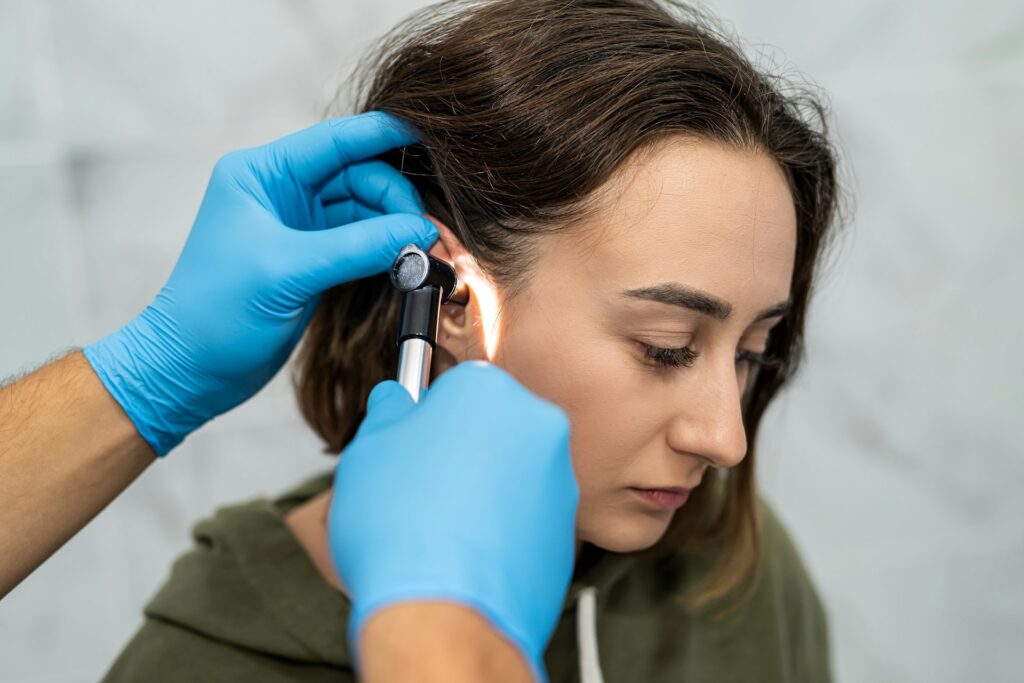Summer is a season filled with outdoor activities, swimming, and sun-soaked adventures. While we slather on sunscreen and stay hydrated, our ears often get overlooked in our summer safety routine. Yet this is precisely when our ears face some of their biggest challenges of the year.
From pool parties to music festivals, the warmer months bring unique risks that can turn a perfect summer day into an uncomfortable – or even dangerous – situation for our hearing health.
What Is ‘Hot Weather Ear’?
‘Hot weather ear’, medically known as otitis externa, affects millions of people each summer. This condition, also commonly called swimmer’s ear, occurs in the external ear due to exposure to hot weather and humidity. The combination of increased heat, humidity, and moisture creates the perfect breeding ground for bacteria and fungi in the ear canal.
Research shows this isn’t just a minor inconvenience. In the UK, outer ear infections are particularly common during summer months, especially in children between seven and 12 years old. What makes hot weather ear particularly troublesome is that the warm, humid environment creates ideal conditions for bacterial growth, while increased sweating and water exposure from summer activities compound the problem.
Summer can also lead to increased earwax buildup. The heat and humidity cause the earwax-producing glands to work overtime, while increased sweating can soften existing wax, making it more likely to form blockages. If you notice symptoms such as earache, feeling of fullness, or temporary hearing loss, it’s important to seek professional ear wax removal rather than attempting to clear it yourself with cotton buds, which can push wax deeper and worsen the problem.
The symptoms often start subtly – perhaps a slight itch or feeling of fullness in the ear. However, if left untreated, hot weather ear can progress to severe pain, hearing difficulty, and discharge. The key is recognising these early warning signs and taking preventive action before a minor irritation becomes a major problem.

Swimming Saviours
Water activities are synonymous with summer fun, but they’re also the leading cause of ear infections during the warmer months. Outer ear infections are particularly common in summer, especially in children, as people are more likely to go swimming and getting water in your ear can sometimes lead to swimmer’s ear infection.
The mechanics are straightforward: when water becomes trapped in the ear canal, it creates a moist environment where bacteria and fungi thrive. Research involving over 50,000 beachgoers found that head immersion swimming significantly increases the risk of developing earaches and infections.
Prevention is remarkably effective and doesn’t require giving up your favourite aquatic activities. After swimming, tilt your head from side to side to allow water to drain naturally. Gently towel-dry the outer ear, and consider using a hair dryer on the lowest setting, held at least 12 inches away, to remove any remaining moisture. Use a bathing cap, ear plugs, or custom-fitted swim moulds when swimming.
For frequent swimmers, a simple home remedy can work wonders: You can make ear drops by mixing 1 part white vinegar to 1 part rubbing alcohol. Using this mixture helps the ear dry and prevents the growth of bacteria and fungi. However, never use this if you have ear tubes or a perforated eardrum.
Read: 8 Top Tips For Staying Safe In The Sun This Summer


Cabin Pressure Preventatives
Summer holidays often mean air travel, and the change in cabin pressure can wreak havoc on your ears. While not strictly a summer-only issue, the increased travel during holiday season makes this particularly relevant for warm-weather ear care.
The key to managing cabin pressure lies in keeping your eustachian tubes – the small passages connecting your middle ear to your throat – functioning properly. During takeoff and landing, try swallowing, yawning, or gently blowing your nose with your mouth closed and nostrils pinched. Chewing gum or sucking on sweets can also help.
If you’re travelling with a cold or congestion, consider using a decongestant about an hour before your flight (always check with your doctor first). Consider bringing some boiled sweets with you. The sucking and swallowing motions help open the eustachian tubes, preventing the painful pressure build-up that can persist long after landing.
Read: Top Tips On Beating Jet Lag Naturally

Summer Concert Care
Concerts and festivals are undoubtedly a highlight of summer, but they pose significant risks to your hearing health. The noise level at an average festival is around 100 decibels. It takes just five minutes of exposure to sound at this level to cause hearing damage.
The solution isn’t to avoid live music altogether – it’s to protect yourself properly. High-fidelity or musician’s earplugs are essential. Unlike cheap foam earplugs that muffle sound quality, these specialised plugs reduce volume while preserving clarity. To prevent hearing damage at a concert or festival, you should wear earplugs with an attenuation of 18 to 25 decibels.
Strategic positioning makes an enormous difference to your risk level. Avoid standing directly in front of speakers, where noise levels can easily exceed 110 decibels, putting you at risk of hearing damage within seconds. Instead, position yourself towards the middle or back of the venue, or off to the side where sound levels are lower. Outdoor venues generally offer better sound dispersion than indoor concerts, where sound waves become trapped and intensified.
Finally, take regular breaks. Audiologists recommend a 15-minute break for every hour of exposure to loud music. Use these breaks to step away from the main stage area and give your ears essential recovery time. Pay attention to warning signs – if you experience ringing in your ears or feeling of fullness, these could indicate the noise level was too high. If symptoms persist beyond 24 hours, consult a healthcare professional promptly.
Read: Top Tips For Combating Summer Eye Problems

Sand & Wind Protection
Beach days bring their own set of ear challenges that many people overlook. Wind can drive sand particles into the ear canal, causing irritation and potentially leading to infection. Similarly, strong coastal winds can create sudden pressure changes that affect your inner ear balance.
When spending time on windy beaches, consider wearing a hat or headband that covers your ears. If sand does get into your ears, resist the urge to dig it out with your fingers or cotton swabs – this often pushes particles deeper and can damage the delicate ear canal skin. Instead, tilt your head and gently shake it to encourage natural removal, or rinse gently with clean water.
For water sports enthusiasts, specially designed ear protection can be a game-changer. Surfers and sailors often use custom-fitted ear plugs that allow sound through while blocking water and wind. These are particularly valuable for anyone spending extended periods in marine environments.
The Bottom Line
Summer ear health doesn’t require major lifestyle changes – just smart precautions. Whether you’re diving into crystal-clear waters, dancing at a music festival, or catching flights to exotic destinations, protecting your ears ensures these experiences remain purely positive memories. For adults, summer ear problems are largely preventable with the right knowledge and preparation.
Remember that ear damage is often cumulative and irreversible. The delicate structures in our ears cannot regenerate after being damaged, and so far, medical science hasn’t discovered a way of repairing them. Taking preventive steps now protects not just your immediate comfort, but your long-term hearing health and quality of life.
This summer, make ear protection as routine as applying sunscreen. Your future self will thank you for it.





